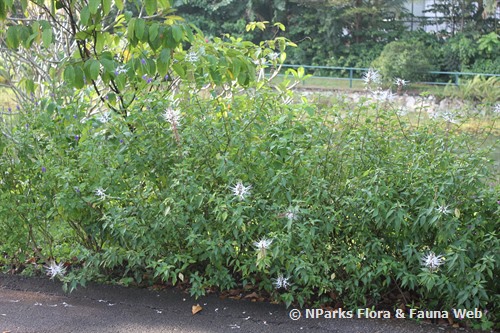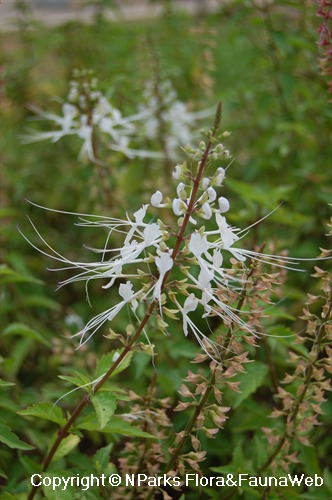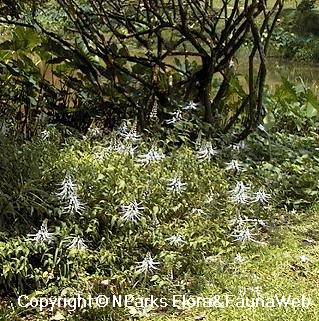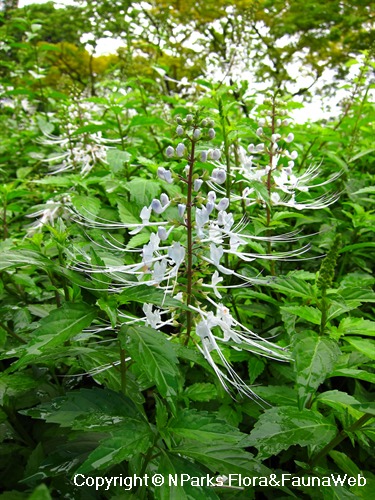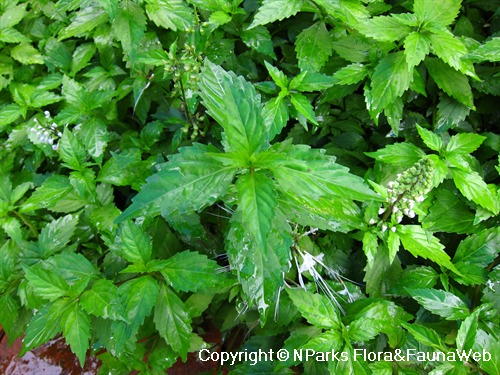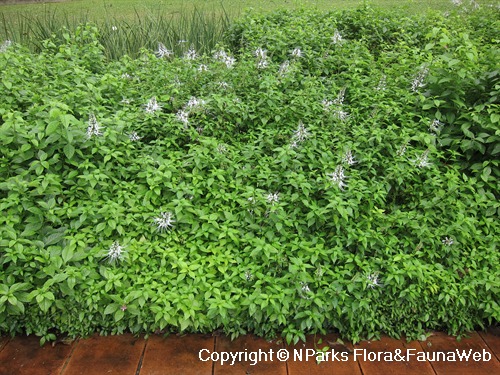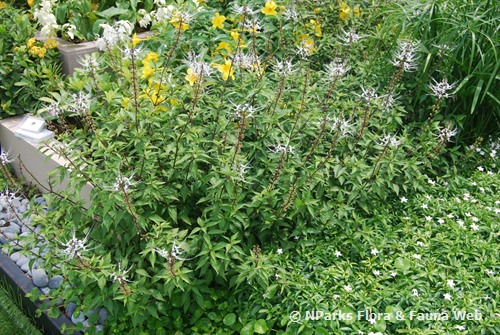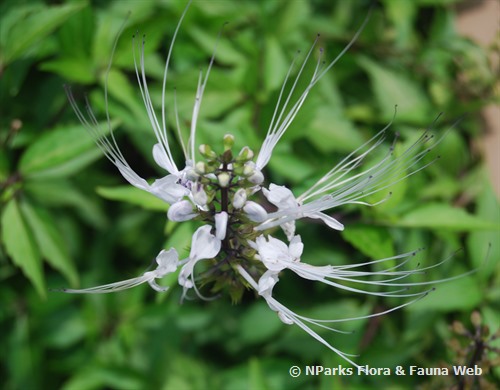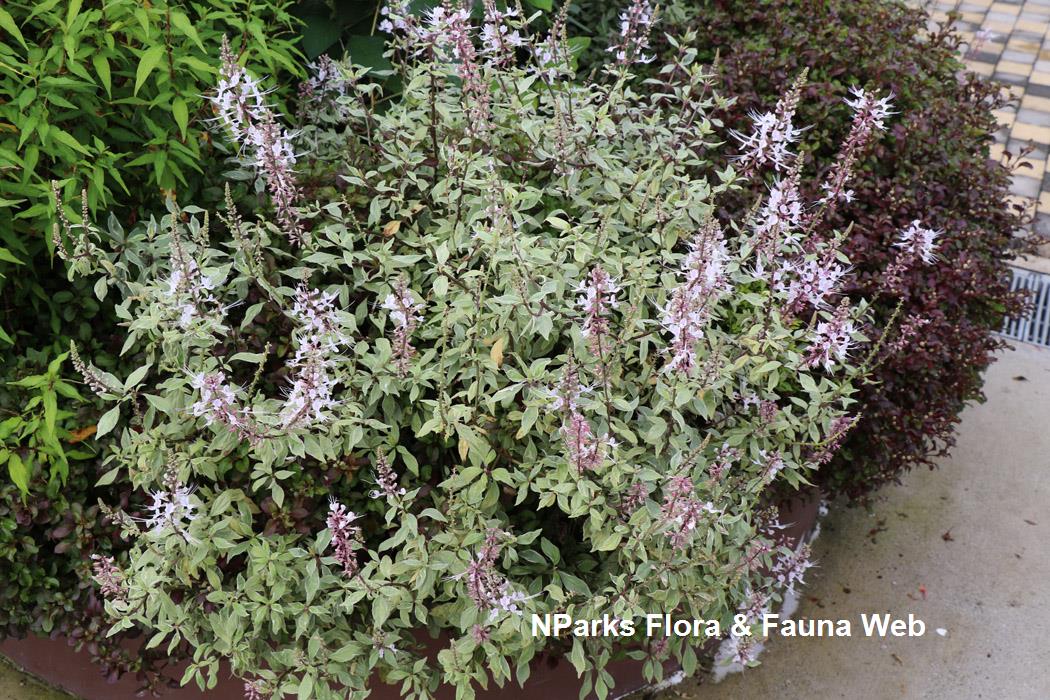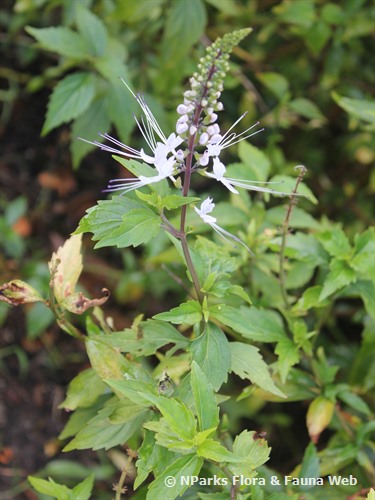
Back
Orthosiphon aristatus (Blume) Miq.
| Family Name: | Lamiaceae (Labiatae) |
| Synonyms: | Orthosiphon stamineus, Orthosiphon spiralis |
| Common Name: | Cat's Whiskers, Java Tea, Kidneys Tea Plant, Misai Kuching, 猫须草 |
Name
Classifications and Characteristics
| Plant Division | Angiosperms (Flowering Seed Plants) (Dicotyledon) |
|---|---|
| Plant Growth Form | Shrub |
| Lifespan (in Singapore) | Perennial |
| Maximum Height | 0.6 m to 1 m |
Biogeography
| Native Distribution | Tropica Asia |
|---|
Description and Ethnobotany
| Growth Form | Perennial herb up to 1 m tall. |
|---|---|
| Foliage | Dark green, smooth leaves are lighter green on the bottom with a toothed leaf margin (5 cm long, 2.5 cm wide). |
| Stems | Purplish stems are 4-sided and smooth. |
| Flowers | White, 2-lipped flowers are hairy with 5 cm-long, whisker-like stamens (male part producing the pollen). Flowers are arranged in a conical-shaped inflorescence (6-10 cm long). |
| Ethnobotanical Uses | Food (Herb or Spice) Medicinal: Scientific Evidence of Medicinal Properties In pre-clinical trials, Cat's Whiskers showed pain-relieving (Yam et al., 2008), anti-cancer (Movahedi et al., 2015), anti-diabetic (Indariani et al., 2014), anti-inflammation (Yam et al., 2008), anti-microbial (Sarshar et al., 2017), antioxidant (Seyedan et al., 2017), and cholesterol-lowering properties (Seyedan et al., 2017) in animals. Traditional Medicinal Uses Research supports the traditional use of Cat's Whiskers to treat diabetes and relieve pain. In India, Cat's Whiskers is taken in combination with Bitterweed (Andrographis paniculata) to treat diabetes. According to Indonesian and Malaysian traditional medicine, bladder or kidney pain, gout, rheumatism and arteriosclerosis can be treated by drinking a decoction of leaves boiled in water. In Vietnamese traditional medicine, a plant infusion is used to treat influenza, hepatits, rheumatism, jaundice and fever, as well as stimulate urination. It is important to note that some therapeutic effects from traditional medicinal uses of plants are not currently supported or verified by scientific research.
|
Landscaping Features
| Desirable Plant Features | Ornamental Flowers |
|---|
Plant Care and Propagation
| Light Preference | Full Sun |
|---|---|
| Water Preference | Moderate Water |
| Plant Growth Rate | Fast |
| Propagation Method | Stem Cutting |
Foliar
| Mature Foliage Colour(s) | Green |
|---|---|
| Foliar Type | Simple / Unifoliate |
| Foliar Shape(s) | Non-Palm Foliage (Ovate) |
| Foliar Margin | Serrate / Toothed |
| Leaf Area Index (LAI) for Green Plot Ratio | 4.5 (Shrub & Groundcover - Dicot) |
Floral (Angiosperm)
| Flower Colour(s) | White |
|---|
References
| References | Indariani, S., Wijaya, H., Rahminiwati, M. & Wien Winarno, M. (2014). Antihyperglycemic activity of functional drinks based on Java Tea (Orthosiphon aristatus) in streptozotocin induced diabetic mice. International Food Research Journal 21(1): 349–355. Movahedi, A., Basir, R., Rahmat, A., Charaffedine, M. & Othman, F. (2015). Orthosiphon stamineus: An Asian tea with substantial anticancer properties. Journal of Nutritional Science and Dietetics 1(1): 44–52. Sarshar, S., Brandt, S., Asadi Karam, M.R., Habibi, M., Bouzari, S., Lechtenberg, M., Dobrindt, U., Qin, X., Goycoolea, F.M. & Hensel, A. (2017). Aqueous extract from Orthosipon stamineus leaves prevents bladder and kidney infection in mice. Phytomedicine 28(15): 1–9. Seyedan, A., Alshawsh, M.A., Alshagga, M.A. & Mohamed, Z. (2017). Antiobesity and lipid lowering effects of Orthosiphon stamineus in high-fat diet-induced obese mice. Planta Med 83(8): 684–692. Wiart, C. (2006). Medicinal Plants of the Asia-Pacific: Drugs for the Future?. Singapore: World Scientific Printers. Yam, M.F., Asmawi, M.Z. & Basir, R. (2008). An investigation of the anti-inflammatory and analgesic effects of Orthosiphon stamineus leaf extract. Journal of Medicinal Food 11(2): 362–368.
|
|---|
Image Repository
Others
| Master ID | 991 |
|---|---|
| Species ID | 2285 |
| Flora Disclaimer | The information in this website has been compiled from reliable sources, such as reference works on medicinal plants. It is not a substitute for medical advice or treatment and NParks does not purport to provide any medical advice. Readers should always consult his/her physician before using or consuming a plant for medicinal purposes. |

